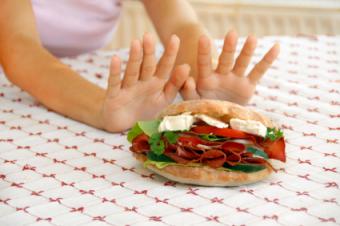
Elimination diets are a great way to help confirm whether following a gluten-free diet will benefit your health. Getting started on an elimination diet can be difficult, but done correctly it can have a major impact on how you feel.
Eliminating Gluten from Your Diet
The gluten free elimination diet is simple in theory and considerably more complicated in application. The gist of the diet is that gluten-containing foods are to be avoided for a specified length of time, long enough for a person to record any physiological reactions experienced. During this elimination period, analyze your system for any positive reactions to the diet. Many persons suffering from celiac disease, gluten allergies and intolerances undergo a long period of ill-health before they are properly diagnosed. Following a gluten elimination diet for two weeks can help you determine if gluten is behind your symptoms.
Because celiac disease can wreak havoc on the digestive tract if untreated, people usually respond well to a gluten-free diet after just a few days. However, in some cases, the body has been damaged to such a degree that other foods like corn and dairy become critical offenders. Therefore, some people choose to do a modified elimination diet, removing all forms of gluten and dairy from their diets, while others choose to do a complete elimination diet at one time, which involves removing foods containing gluten from your diet for two weeks before adding them back in one at a time and watching for a reaction.
Choosing a Length of Time
It takes time for allergens and gluten particles to completely leave your system. Therefore, most elimination diets are recommended to be followed for a minimum of one to two weeks. After this time, you can reintroduce the foods one at a time and watch for a reaction. People with more severe symptoms may choose to follow the elimination diet for two to four weeks instead.
The Ubiquity of Gluten
If you are looking to eliminate gluten from your diet for health or merely weight related reasons, you will need to be aware of the many hidden dietary sources of gluten that can aggravate your efforts. Going gluten-free should be as simple as avoiding all grains with the exception of rice and corn, but there may be many other sources of gluten that must be avoided during the elimination diet. This list includes grains and products such as:
- Wheat
- Semolina
- Spelt
- Kamut
- Rye
- Oats
- Barley
- Malt
- Processed foods
- Cold cuts
- Shredded cheeses
- Gravies
- Beer
- Food starch
- Modified food starch
- Maltodexterin
- Soy Sauce
It is very easy for gluten-free dieters to sometimes pick up a packet of pasta and read "100% Organic Semolina," not realizing that semolina is just another term for wheat. The above foods are all potential sources of the protein gluten and are, therefore, should not be consumed while going through the elimination diet.
There are many non-grain based foods that still contain supplemental gluten due to its viscose thickening properties. Awareness regarding these hidden gluten sources is very important for potential celiac sufferers. Foods such as soy sauce, ketchup and processed foods containing modified food starch can often contain gluten. Your best bet for a healthy gluten-exempt diet is to stick to whole unprocessed foods during the elimination period. This will help you make a closer connection between certain foods and your symptoms.
Reintroduction
Once you've concluded the elimination phase of the diet, begin introducing foods back into your diet one at a time. If you've chosen only to eliminate gluten, or a modified elimination diet eliminating gluten and dairy, the reintroduction phase is as simple as adding one of those items back and watching for a reaction.
If you've chosen a full elimination diet, keep a food journal to help you keep track, and try adding foods back one every 24 to 48 hours. Record which foods caused a reaction, what the reaction was and how long it lasted and bring the journal to your doctor to review.
Talk to Your Doctor
If you are considering a gluten elimination diet to help determine if you have a gluten intolerance of Celiac disease, speak to your doctor first. Your doctor may ask you to wait until after testing, because celiac can only be detected if you have been eating gluten in your current diet.







